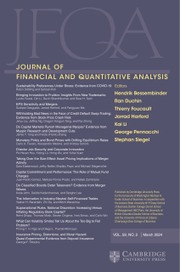No CrossRef data available.
Article contents
Does Speculative News Hurt Productivity? Evidence from Takeover Rumors
Published online by Cambridge University Press: 13 May 2025
Abstract
We show that productivity at both the firm and employee (i.e., analyst and inventor) level temporarily declines upon announcements of takeover rumors that do not materialize. Such speculative news may hurt productivity because uncertainty and the threat of job loss cause anxiety, distraction, and reduced commitment among employees and managers. Consistently, we observe a more pronounced productivity dip for rumored targets and when the likelihood of job loss is higher. Firm performance mirrors these results. We find no indication of reverse causality. The evidence fosters our understanding of potential real effects of speculative financial news and the costs of takeover threats.
Information
- Type
- Research Article
- Information
- Journal of Financial and Quantitative Analysis , Volume 60 , Issue 6 , September 2025 , pp. 2952 - 2996
- Creative Commons
- This is an Open Access article, distributed under the terms of the Creative Commons Attribution licence (http://creativecommons.org/licenses/by/4.0), which permits unrestricted re-use, distribution and reproduction, provided the original article is properly cited.
- Copyright
- © The Author(s), 2025. Published by Cambridge University Press on behalf of the Michael G. Foster School of Business, University of Washington
Footnotes
We are grateful to Nihat Aktas, Marieke Bos (EFA discussant), Tom Chemmanur, Ettore Croci, Andrew Ellul, Eliezer Fich, Andrey Golubov, Jarrad Harford (the editor), Martin Jacob, Amy Li (DGF discussant), Raghu Rau, Markus Schmid, Henrik Schürmann, Merih Sevilir, Karin Thorburn, as well as to participants at a CFR research seminar, at the 2021 conference of the French Finance Association (AFFI), at the 2022 meeting of the European Finance Association (EFA), at the 2022 meeting of the German Finance Association (DGF), and at the 2022 BFGA conference for very helpful comments and suggestions.

